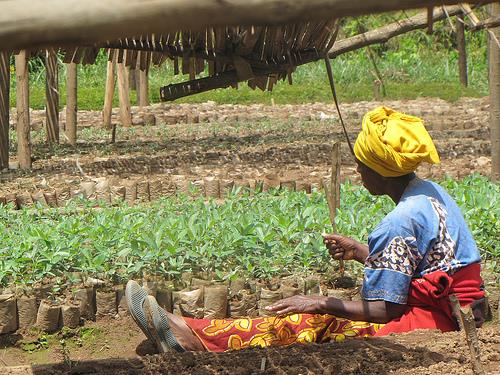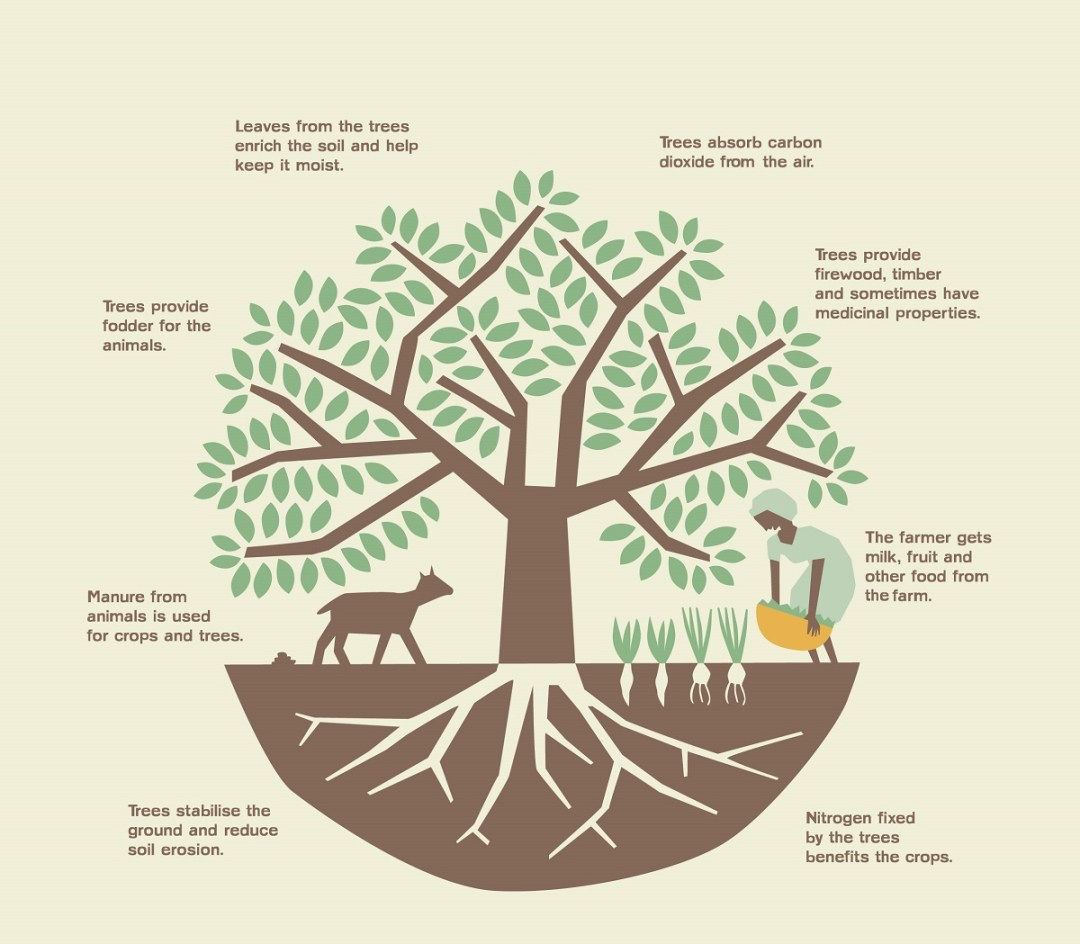Forestry and Agroforestry
The Ministry of Natural Resources has the mission to ensure the protection and conservation of the environment and ensure optimal and rational utilization of natural resources for sustainable national development. Forestry and agroforestry are major components of the catchment rehabilitation plans to restore and protect the natural infrastructure. Forests and agroforestry support the livelihoods of farmers through the provision of biological products (food/fruits, fodder, medicines, construction materials and fuel), as well as services - supporting (soil fertility, moisture, biodiversity), regulating (micro/macro climate, water/air quality), and cultural/recreational services. Forest contributes to healthy catchments and healthy people.
The forest ecosystem services are essential for the resilience of the landscapes for rural people to adapt to environmental and climate stress. Forests also stabilize soil and reduce erosion, regulate water flow to mitigate floods and droughts, and purify water: they are part of the basic conditions that allow business to grow.
Forestry
In the framework of the Bonn challenge Rwanda pledged to increase the current 29,6 % covered with forest. Rwanda with 2 million hectareas with forest. Rwanda spearheaded the Declaration on Forest Landscape Restoration in Africa in 2016. Natural forest like Nyungwe and Ghiswati focus is on conservation with high values for biodiversity, tourism, ecological services. Small patches of original woodlot exist in parts of the country. These woodlots harbour unique biodiversity and are important elements in the landscape.
Production forests combine ecological services with more focus on the financial productivity.
By law, slopes over 60% need to be forested against erosion and landslides. 30% of the forest cover is public while private woodlots cover 70%. The small plots with different owners pose an extra challenge for commercial forest management arrangements.
The productivity of the private and public (District owned or Government owned) is generally low. With a participatory management plans the production can be far higher.This implies restocking, diversification with high value varieties, maintainance and planned harvest. The customary (often informal) use of the forest by local population especially the vulnerable groups that derive useful products should be respected or compensated when they are denied access.
The ownership and tenure of forest land and forest products is not always clear. Private forest have been restocked by government / NGOs without establishing the ownership of the land and the rights to harvest. The unclear property and tenure situation of forest land hampers investments in restoration and management.
The new generation District Forestry plans based on forestry concessions are promising. These plans under elaboration will be based on Public Private Partnership agreements between the District authority or the Ministry and a company around forest management units consisting of a number of forest/woodllots.
One existing concession is with NewForest company who manages the bufferzone around Nyugwe National Park.The company produces low value Eucalyptus poles for the electrification in Rwanda and the region.
Agroforestry
Agroforestry is the combination of agricultural and forestry technologies to create integrated, diverse and productive land use systems. Agroforestry in combination with terraces is necessary to reduce erosion, and increase the infiltration. Agroforestry supports food security and more sustainable agricultural production. If the household can choose the trees for a source of fuel, beautification, shade or improvement of soil fertility windbreaks or fruit production, agroforestry can play an important role in the reduction of poverty while protecting the environment sustainably.

The core intervention of catchment restoration is the intensification and diversification of agroforestry techniques; this will involve extending the diversity and intensity of agroforestry trees already used to stabilize the slopes of terraces and improve soil fertility, promotion of perennials and tree‐crops (including tea, shade coffee, fruit trees, etc), intercropping or planting of in‐field trees, and shelter‐belts / live‐fences. Forestry management promote the use of local species, such as Podocarpus, Polyscias fulva, Entantophrama, Croton megalocarpus, Markhamia lutea, Vernonia Amydalina Mytragyna, and Sygygium, in addition to exotics like Alnus acuminata, Acacia Agustima and Acacia melanoxylon in combination with commercial species to generate the revenue in the business plan. Bamboo is also a crop that can be used in the agroforestry. It grows fast

Sustainable (agro)forestry management
Well-planned and managed (agro)forestry can be profitable. The overall goal of the national forestry policy is to make the forestry sector one of the bedrocks of economy and national ecological balance for sustainable benefits to all segments of the society.Wood/timber and other products like honey, fruits and tourism can be used to generate income (cash flow). Choice and mix of species and a management plan has to respond to the goal of conservation as well as to a business model. Single species (Eucalyptus) might satisfy the need for fast growing wood but with dominant negative side effects of drying out the soil and not allowing undergrowth are not part of a viable business plan.
In productive forest and agroforestry systems, trees are part of a value chain as any other crop. When a forest is planted without a buyer for when it reaches its maturity this forest will be less sustainable than a forest that has a customer and know the final use the wood (paper, furniture, construction, electricity poles).
FURTHER READING:
MINIRENA Forestry Policy
FAO Toolbox sustainable forest management
REMA Practical tools on agroforestry
FAO Forestry and climate change brochure
FAO field manual Landscape restoration and a watershed management
ICRAF World Agroforestry in Rwanda
Videos:
Vi-Agroforestry videos: Agroforestry in Rwanda Tree clubs in schools Rwanda
FAO video Forest and green economy
